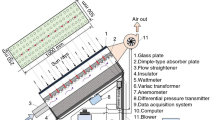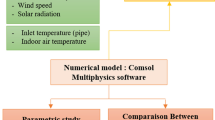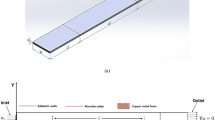Rapid development of the technologies of use of renewable energy sources in the recent decade has opened up prospects for satisfying our society′s ever growing needs for fuel and power resources. In the present work, the author has shown results of investigation into the thermal and aerodynamic characteristics of a solar air heater. A computer model whose adequacy has been confirmed using experimental data was developed in the ANSYS Fluent software product. It has been determined that for the end of calendar autumn, the operating efficiency of the solar air heater is the highest at the angle of inclination of the absorption surface to the earth α = 60°. The dependence of the value of heating of air in the solar heater during daylight hours has been determined in the physical and computer experiment; it has been established that for the city of Samara (GMT + 4) the maximum air heating is observed in the interval between 13.00 and 14.00. The influence of transverse ribs on the heat exchange between the light-absorbing surface and the air has been shown. A curvilinear shape of the temperature contour is formed in the immediate vicinity of the ribs due to the formation of vortices and reverse-current zones.
Similar content being viewed by others
References
E. N. Sosnina, O. V. Masleeva, and E. V. Kryukov, Comparative environmental assessment of nontraditional-power facilities, Teploénergetika, No. 8, 3−11 (2015).
G. B. Osadchii, Solar energy: renewable energy of universal importance, Vestn. Razv. Nauki Obraz., No. 5, 8−13 (2012).
N. K. Liseitsev and A. A. Samoilovskii, Status, problems, and prospects for developing aircraft using solar energy for flight, Trudy MAI, No. 55, 11−13 (2012).
A. E. Kabeel and K. Mecarik, Shape optimization for absorber plates of solar air collectors, Renew. Energy, 13, 121−131 (1998).
F. Ozgen, M. Esen, and H. Esen, Experimental investigation of thermal performance of a double-flow solar air heater having aluminium cans, Renew. Energy, 34, 2391−2398 (2009).
T. Alam, R. P. Saini, and J. S. Saini, Effect of circularity of perforation holes in V-shaped blockages on heat transfer and friction characteristics of rectangular solar air heater duct, Energy Convers. Manage., 86, 952−963 (2014).
L. Wang and B. Sunden, An experimental investigation of heat transfer and fluid flow in a rectangular duct with broken V-shaped ribs, Exp. Heat Transf., 17, 243−259 (2004).
H. Esen, Experimental energy and energy analysis of a double-flow solar air heater having different obstacles on absorber plates, Build. Environ., 43, 1046−1054 (2008).
R. Karwa and B. K. Maheshwari, Heat transfer and friction in an asymmetrically heated rectangular duct with half and fully perforated baffles at different pitches, Int. Commun. Heat Mass Transf., 36, 264−268 (2009).
P. Promvonge, C. Khanoknaiyakarn, S. Kwankaomeng, and C. Thianpong, Thermal behavior in solar air heater channel fitted with combined rib and delta-winglet, Int. Commun. Heat Mass Transf., 38, 749−756 (2011).
M. N. Nikitin and A. A. Tsynaeva, Study of the flow in a channel with dumbbell-shaped dimples, Procedia Eng., 150, 2340−2344 (2016).
M. N. Nikitin and D. O. Kortyaeva, Numerical study of natural convection in an enclosed volume, Vestn. Samarsk. Gos. Arkhit.-Stroit. Univ., Gradostroit. Arkhitektura, No. 3, 146−150 (2016).
Author information
Authors and Affiliations
Corresponding author
Additional information
Translated from Inzhenerno-Fizicheskii Zhurnal, Vol. 92, No. 1, pp. 77–83, January–February, 2019.
Rights and permissions
About this article
Cite this article
Pashchenko, D.I. CFD Modeling of Operating Processes of a Solar Air Heater in ANSYS Fluent. J Eng Phys Thermophy 92, 73–79 (2019). https://doi.org/10.1007/s10891-019-01908-8
Received:
Published:
Issue Date:
DOI: https://doi.org/10.1007/s10891-019-01908-8




